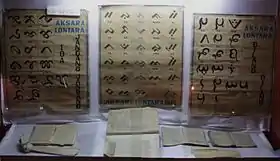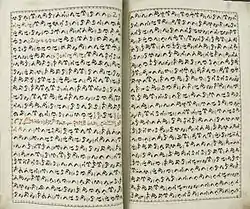Makassarese language
Makassarese (basa Mangkasara'), sometimes spelled Makasar, Makassar, or Macassar, is a language of the Makassarese people, spoken in South Sulawesi province of Indonesia. It is a member of the South Sulawesi group of the Austronesian language family, and thus closely related to, among others, Buginese.
| Makassar | |
|---|---|
| Bahasa Makassar | |
| ᨅᨔ ᨆᨀᨔᨑ Basa Mangkasara' | |
| Native to | Indonesia |
| Region | South Sulawesi (Sulawesi) |
Native speakers | 2.1 million (2000 census)[1] |
| Dialects |
|
| Lontara (present) Latin (present) Old Makassarese (historical) | |
| Language codes | |
| ISO 639-2 | mak |
| ISO 639-3 | mak |
| Glottolog | maka1311 |
Phonology
The following description of Makassarese phonology is based on Jukes (2005).[2]
Vowels
Makassarese has five vowels: a, e, i, o, u.
Consonants
| Labial | Alveolar | Palatal | Velar | Glottal | ||
|---|---|---|---|---|---|---|
| Nasal | m | n | ɲ | ŋ | ||
| Plosive | voiceless | p | t | c | k | ʔ |
| voiced | b | d | ɟ | ɡ | ||
| Fricative | s | h | ||||
| Semivowel | j | w | ||||
| Lateral | l | |||||
| Trill | r | |||||
Phonotactics
All consonants except for /ʔ/ can appear in initial position. In final position, only /ŋ/ and /ʔ/ are found.
Consonant clusters only occur medially and (with one exception) can be analyzed as clusters of /ŋ/ or /ʔ/ + consonant. These clusters also arise through sandhi across morpheme boundaries.
| nasal/lateral | voiceless obstruents | voiced stops + r | |||||||||||||
|---|---|---|---|---|---|---|---|---|---|---|---|---|---|---|---|
| m | n | ɲ | ŋ | l | p | t | c | k | s | b | d | ɟ | ɡ | r | |
| /ŋ/ | mm | nn | ɲɲ | ŋŋ | ll | mp | nt | ɲc | ŋk | ns | mb | nd | ɲɟ | ŋg | nr |
| /ʔ/ | ʔm | ʔn | ʔɲ | ʔŋ | ʔl | pp | tt | cc | kk | ss | ʔb | ʔd | ʔɟ | ʔg | ʔr |
The geminate cluster /rr/ is only found in root-internal position and cannot be accounted for by the above rules.
Sequences of like vowels are contracted to a single vowel, e.g. sassa "to wash" + -ang 'nominalizing suffix' > sassáng "laundry", ca'di "small" + -i 'third person' > ca'di "it is small".
Current writing systems
Although Makassarese is now often written in Latin script, it is still widely written using Lontara script, which once was used also to write important documents in Bugis and Mandar, two related languages from Sulawesi.

Examples
Some common words/phrases in the Makassar language, transcribed in the Latin script, are as follows ( ' = glottal stop):
| Lontara | Romanized | Indonesian | Translation |
|---|---|---|---|
| ᨅᨒ | balla' | rumah | house |
| ᨅᨘᨒᨘ | bulu | bulu | body hair/fur |
| ᨅᨅ | bambang | panas | hot/warm |
| ᨌᨗᨄᨘᨑᨘ | cipuru' | lapar | hungry |
| ᨉᨚᨕᨙ | doe' | uang | money |
| ᨕᨗᨐᨚ | iyo | iya | yes |
| ᨒᨚᨄᨚ | lompo | besar | big/large |
| ᨔᨒᨚ | sallo | lama / lambat | slow / long (time) |
| ᨈᨅᨙ | tabe' | permisi | excuse me |
| ᨈᨙᨊ | tena | tidak ada | none |
| ᨀᨑᨕᨙ | karaeng | raja | king |
| ᨕᨄ ᨀᨑᨙᨅ? | apa kareba? | apa kabar? | how are you? |
| ᨒᨀᨙᨀᨚ ᨆᨕᨙ? | lakeko mae? | kamu mau ke mana? | where are you going? |
| ᨅᨒ | ballang | belang | get tanned |
| ᨅᨚᨈᨚ | botto' | bau | smelly |
| ᨑᨈᨔ | rantasa' | jorok | disgusting |
| ᨅᨈᨒ | co'mo' | gemuk | fatty |
| ᨅᨗᨒ | bella | jauh | far away |
| ᨁᨙᨒᨙ ᨁᨙᨒᨙ | gele'-gele' | geli | tickle |
| ᨀᨚᨀᨚ | kongkong | anjing | dog |
| ᨍᨑ | jarang | kuda | horse |
| ᨅᨙᨅᨙ | bembe' | kambing | goat |
| ᨆᨚᨈᨙᨑᨙ | ammotere' | pulang ke rumah | return home |
| ᨂᨑᨙ | angnganre | makan | eat |
Historical writing system
| Makasar Old Makassarese / Makassarese bird script | |
|---|---|
| Direction | Left-to-right |
| ISO 15924 | Maka, 366 |
Unicode alias | Makasar |
| U+11EE0–U+11EFF | |
Makassarese was historically written using Makasar script (also known as "Old Makassarese" or "Makassarese bird script" in English-language scholarly works).[3] In Makassarese the script is known as ukiri' jangang-jangang or huruf jangang-jangang ("bird letters"). It was used for official purposes in the kingdoms of Makasar in the 17th century but ceased to be used by the 19th century, being replaced by Lontara script.
In spite of their quite distinctive appearance, both the Makasar and Lontara scripts are derived from the ancient Brahmi script of India. Like other descendants of that script, each consonant has an inherent vowel "a", which is not marked. Other vowels can be indicated by adding diacritics above, below, or on either side of each consonant.

Unicode
Makasar script was added to the Unicode Standard in June, 2018 with the release of version 11.0.[4]
The Unicode block for Makasar is U+11EE0–U+11EFF and contains 25 characters:
| Makasar[1][2] Official Unicode Consortium code chart (PDF) | ||||||||||||||||
| 0 | 1 | 2 | 3 | 4 | 5 | 6 | 7 | 8 | 9 | A | B | C | D | E | F | |
| U+11EEx | 𑻠 | 𑻡 | 𑻢 | 𑻣 | 𑻤 | 𑻥 | 𑻦 | 𑻧 | 𑻨 | 𑻩 | 𑻪 | 𑻫 | 𑻬 | 𑻭 | 𑻮 | 𑻯 |
| U+11EFx | 𑻰 | 𑻱 | 𑻲 | 𑻳 | 𑻴 | 𑻵 | 𑻶 | 𑻷 | 𑻸 | |||||||
| Notes | ||||||||||||||||
See also
References
- Makassar at Ethnologue (18th ed., 2015)
- Jukes, Anthony, "Makassar" in K. Alexander Adelaar & Nikolaus Himmelmann, 2005, The Austronesian languages of Asia and Madagascar, pp. 649-682, London, Routledge ISBN 0-7007-1286-0
- Pandey, Anshuman (2015-11-02). "L2/15-233: Proposal to encode the Makasar script in Unicode" (PDF).
- "Unicode 11.0.0". Unicode Consortium. June 5, 2018. Retrieved June 5, 2018.
Further reading
- Jukes, Anthony (2020). A Grammar of Makasar: A Language of South Sulawesi, Indonesia. Leiden & Boston: BRILL. ISBN 978-90-04-41266-8.
External links
| Look up Appendix:Makasar Swadesh list in Wiktionary, the free dictionary. |
| Makassarese language test of Wikipedia at Wikimedia Incubator |
